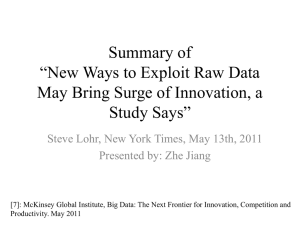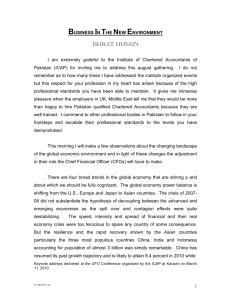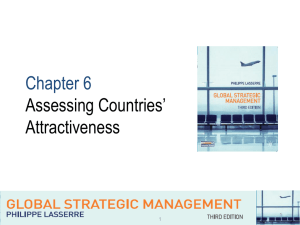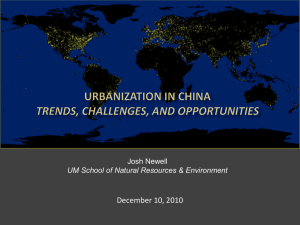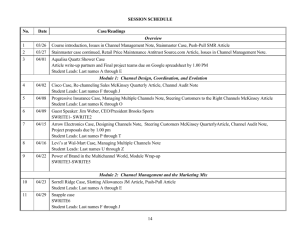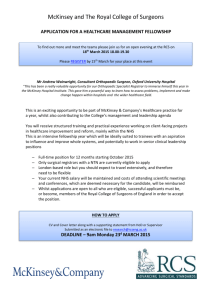Concrete steps for CFOs to improve strategic risk management
advertisement
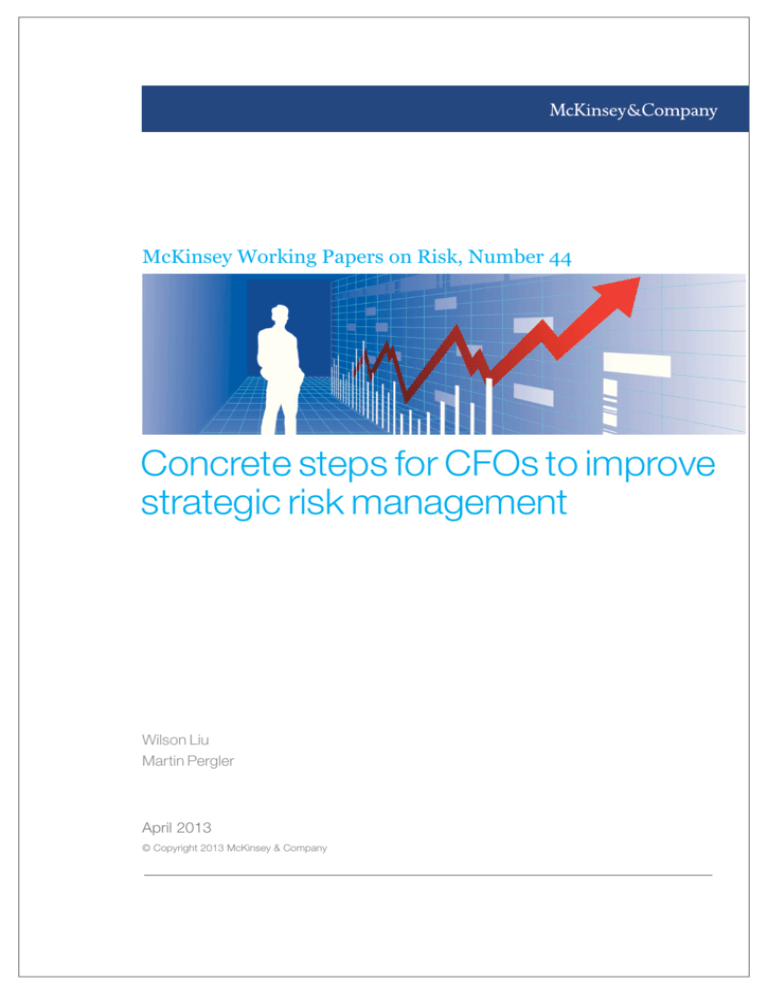
McKinsey Working Papers on Risk, Number 44 Concrete steps for CFOs to improve strategic risk management Wilson Liu Martin Pergler April 2013 © Copyright 2013 McKinsey & Company Contents Concrete steps for CFOs to improve strategic risk management Introduction1 Conventional risk management 1 Role of the CFO 2 Build a tight link between risk management and business-planning processes 2 Lead a corporate-level discussion of risk preference, focusing on which risk choices will most likely deliver economic profit for the company 5 Use risk analytics to inform investment and strategic decisions 5 McKinsey Working Papers on Risk presents McKinsey’s best current thinking on risk and risk management. The papers represent a broad range of views, both sector-specific and cross-cutting, and are intended to encourage discussion internally and externally. Working papers may be republished through other internal or external channels. Please address correspondence to the managing editor, Rob McNish (rob_mcnish@mckinsey.com). 1 Concrete steps for CFOs to improve strategic risk management Introduction Most major companies have risk-management processes in place to identify, assess, and respond to ongoing and emerging risks to the business. Yet many are finding these processes inadequate for today’s volatile and uncertain environment. One crucial gap is strategic risk management—understanding of the critical, enterprise-wide risks affecting the company’s ability to reach all of its strategic aspirations; making deliberate choices as to which risks to take; and having explicit consideration of risk/return trade-offs during major business decisions—as opposed to risk mitigation to manage surprises once decisions are made and are being executed. Good strategic risk management requires a concerted effort by all top decision makers. As stewards of a company’s financial health, CFOs need to play a lead role in orchestrating these efforts. Fortunately, key elements of strategic risk management are natural extensions of several activities CFOs already perform, so it is relatively easy to lead by example. Conventional risk management In any company, risk taking is a fact of life, and the first line of defense against undesirable or excessive risk lies in the actions and decisions of line management. Typically, specific risk policies are in place, so these decisions are not arbitrary, but it is line management who is responsible. Exhibit 1 gives a simple view of this approach, which involves a risk register that often runs to hundreds, sometimes thousands, of items. At the other extreme, overall risk oversight is the ultimate responsibility of the board of directors. Most companies attempt to bridge the chasm between the two by having a small central risk function in place to manage a comprehensive list of risks identified throughout the business, with an assessment of severity, probability, and, ideally, mitigation actions and who is responsible. A description of the synthesis of risk responsibilities is created for top management and the board, often in the form of a dashboard or heat map. Exhibit 1 A comprehensive risk register is a typical but insufficient practice. Control ▪ Select mitigation actions to be reviewed systematically ▪ Automatically updated with data surfaced from project organization Mitigation actions ▪ Actions required for each risk under a certain group Risk group ▪ Risk groups combine related risks to allow for clear owner assignment and effective mitigation tracking Description of risk item ▪ Specific risks under each grouping will be the base for: – Likelihood and impact evaluation – Mitigation action development and tracking Status ▪ Current status of each action (eg, not started, behind schedule, on schedule, ahead of schedule) Comments and completion date ▪ Comments explaining the status or required actions ▪ Date expected of mitigation completion 2 This approach, when it stops there, suffers from four deficiencies. First, the risks considered are usually heavily biased toward current operations and rarely include risks affecting plans related to future growth (for example, what will it take to deliver a megaproject that currently exists only on paper, or to meet an aspirational revenue or profitability target in an uncertain economy?). This bias is more severe for medium- and long-term plans than for the current financial plan. Second, this approach often misses crucial external factors which people “inside the machine” view as beyond their control (for example, important regulatory change or supplier performance) but which may well be the most important risks the company needs to be ready to deal with. Third, the whole process feels like a deathly boring review of what everyone already knows, or even an unpleasant, necessary evil, like going to the dentist. Finally, and perhaps most damningly, risk management done this way kicks in too late to be strategic. Risks bubble up for discussion once plans have been approved and decisions made—it’s all about risk mitigation and very little about risk choices and trade-offs that might inform a company’s strategy. Role of the CFO In addition to managing financial-operation risks (such as liquidity and counterparty credit), CFOs can further augment their roles as stewards of their company’s financial health through three concrete steps in strategic risk management. Below, we illustrate each step with examples from capital-intensive companies, which have been at the forefront of adapting them because they tend to face decisions involving very large commitments and associated implied bets. However, these leading practices can equally be applied to companies in other industries.1 Build a tight link between risk management and business-planning processes The linkage between risk management and business-planning processes is weak at most companies. Risk analysts focus on today’s issues rather than those they foresee emerging in the future. Quantification is done at a high level for the purposes of prioritization, but it is often unclear exactly what businessperformance metrics would be affected. On the other side, business planners conduct ad hoc analysis of upside versus risk, focusing most, if not all, of their attention on a single “center cut” scenario. Any analysis of risk and upside is likely based on assumptions linked to an incomplete set of risk factors. We have seen CFOs improve their business planning—and catalyze strategic-risk-management improvement—with the following specific actions: Pinpointing exactly where and how risk will affect the business plan. A major basic-materials company has begun to annotate a specific list of top-priority risks on its executive management reports, as shown in Exhibit 2. It even color codes key metrics based on their level of risk exposure. This helps the executive committee to focus on the specific challenges and actions required to meet their performance goals and is much more useful than a typical impact-likelihood risk heat map, which forces risk-centric thinking rather than business-centric thinking about risks. 1 In this article, we focus on corporates, rather than financial institutions, which have developed specialized riskmanagement approaches because risk intermediation is an inherent element of their business model. 3 Concrete steps for CFOs to improve strategic risk management Exhibit 2 An integrated dashboard pinpoints sources of risk. DISGUISED BASICMATERIALS EXAMPLE Heat-map example $ million High risk EBITDA1 by country 2010 2011 Latin America Europe Canada US Asia Africa Pacific Total EBITDA 1,000 500 250 12 250 200 75 10 25 2,300 1,107 520 Working capital Taxes 6 9 3 Cash generation from operations Maintenance CAPEX Significant risk Moderate risk 2014 Risk events2 1,230 900 205 1,810 103 82 53 4,383 1 2012 2013 243 350 189 81 27 2,517 1,080 648 210 5 720 210 96 36 3,000 1,120 837 175 1,155 105 70 39 3,500 (180) (300) (25) (430) (95) (400) (80) (500) (70) (650) 1,821 (300) 2,063 (400) 2,506 (550) 2,921 (600) 3,664 (650) 8 5 Strategic CAPEX (200) (200) (250) (250) (400) Fixed asset sales 100 80 30 10 - (400) (520) (770) (840) (1,050) (50) (50) (50) (55) (25) (30) (35) (35) Net investment in fixed assets Other cash expenses 7 Other uses of free cash flow (80) (65) Total free cash flow from operations Net financial expense Total cash generated 1 2 1,276 1,468 1,656 1,996 (1,198) (1,328) (1,476) (1,433) 78 140 180 562 2,524 11 Upside benefit (1,221) 2 3 Unwind fee for JV dissolution Change in regulation in United States Unfavorable tax negotiation 4 Failure to secure lender agreements 5 Lower-than-predicted growth in US revenues 6 Drop in volumes in Asia 7 Integration failure 1,302 Financial cash uses Equity, convertible Debt conversion 8 1,000 4 400 150 260 150 (478) (290) (440) (712) (1,362) (78) (140) (180) (562) (1,302) Other 85 Debt repayment Total Financial cash uses 60 9 10 Consolidated total debt Initial balance 15,500 15,022 14,732 14,292 13,579 Debt down payment (478) (290) (440) (712) (1,362) 15,022 14,732 14,292 13,579 12,217 6.5 5.9 4.8 3.9 2.8 End balance Debt: EBITDA 4 1 Earnings before interest, taxes, depreciation, and amortization. 2 Risks classified according to 4 buckets of risks: high, significant, moderate, and opportunities based on estimates of impact ($) and probability (%). Change in political environment in Africa Delays in capex project Disruptions in operations 11 Renegotiation of interest expenses 12 Increase in volumes in Canada 4 Incorporating systematic stress testing as part of financial planning. A leading real-estate firm forecasts key financial metrics (for example, interest-coverage ratio) under comprehensive macroeconomic scenarios, with key assumptions developed at the market level. This approach provides management with greater confidence that the business plan is robust under a range of potential macroeconomic scenarios. Exhibit 3 shows an example of the potential impact on the business of various scenarios, including in combination.2 Exhibit 3 Stress testing the business portfolio using integrated macroscenarios reveals possible impact. 2006 GLOBAL REALESTATE EXAMPLE …and draw implications for business viability Stress test business portfolio against integrated “macroworld” scenarios… 1 Housing-price bubble bursts High Housing-price bubble bursts 2 China’s growth hits a bump 1 1 + 2 “Perfect storm” 2 China’s growth hits a bump Likelihood 6 Europe declines Low Credit rating reduced 3 High oil prices 4 Protectionism rises 8 Climate change Banking covenants broken 7 Health pandemic 5 US financial collapse Low Bankruptcy High Impact EBITDA1 2006 2007 2008 2009 2010 2011 3–6 early-warning indicators developed for each risk 1 Earnings before interest, taxes, depreciation, and amortization. Applying probabilistic “financials at risk” modeling for major investment decisions. Instead of focusing on a single scenario, at-risk modeling provides insights on the probability of success. Companies facing numerous correlated, volatile risks are increasingly using such models to evaluate the aggregate impact of these risks on the potential investment return. Exhibit 4 shows in simplified form the output of such an exercise, reflecting a company’s potential deviations from baseline plan based on volatile commodity prices (a key cost driver), foreign-exchange rates, and demand and price sensitivity. The error bars represent a 5th- and 95th-percentile confidence interval under reasonable assumptions about how these factors would behave together, showing that in spite of an expected performance turnaround, there is still significant risk to be managed. This approach complements rather than replaces stress testing; in fact, in this case the assumptions specifically reflect only random commodity, foreign-exchange, and demand volatility, assuming current macroeconomic fundamentals continue to hold. Radical shifts (with impossible-to-estimate probabilities) were explored using stress testing. Nevertheless, the fact that even unremarkable levels of market volatility might well push company performance to uncomfortable levels was a powerful wake-up call. 2 For more information, see McKinsey Working Papers on Risk, Number 8: “Shaping strategy in an uncertain macroeconomic environment,” December 2008 (mckinsey.com). 5 Concrete steps for CFOs to improve strategic risk management Exhibit 4 Simplified output shows potential deviations. Consolidated fungible cash year-end vs. cash needs AIRLINE EXAMPLE $ million (5% and 95% error bars) 600 400 205 200 50 70 Q4 2012 2013 2014 <5 35 45 0 –200 –400 –600 Probability of not meeting cash needs, % Lead a corporate-level discussion of risk preference, focusing on what risk choices will most likely deliver economic profit for the company As the principal manager of the company’s capital structure, the CFO is the custodian of the company’s ultimate risk capital: equity. Risk taking is necessary for growth, so the question becomes which risks provide the most bang for the buck. CFOs cannot answer this question alone, but they can lead the top management (and board) discussion on risk appetite and preference and ground it with facts about implications. For instance, historically the question of fuel hedging by airlines has been addressed as essentially a purchasing issue: how can an airline best try to lock in an advantageous cost position (or at least protect against an unfavorable one)? But the combination of industry overcapacity, increased fuel-cost volatility, and mergers has lifted fuel strategy up to the status of a fundamental corporate-finance question. What level of unhedged fuel (and currency) risk is acceptable given low operating margins and high cash needs? What level of hedging is acceptable given collateral requirements and mark-to-market requirements for hedge positions? How to balance this with the potential windfall opportunity to steal share or capture profits if one is hedged differently than competitors when fuel prices move? Use risk analytics to inform investment and strategic decisions CFOs already play important roles in the financial and strategic aspects of investment and the evaluation of other major decisions. Not only do they typically lead discussion on rival proposals and solutions, they also often have powerful decision rights, not least in choosing what gets presented to top management for debate. They should mandate and support a similar type of risk assessment, as discussed above. Too often, major projects with value at stake comparable to the total risk from current company operations are discussed and decided on with at most a one-page qualitative list of the major risks. The CFO can ensure discipline by defining the right set of core financial and risk analytics to run for each option on the table to ensure this value at stake is brought to light and debated. For instance, the CFO of a national oil company worked with the portfolio manager to run “what-if” stress tests for several aspirational future strategic portfolios (for example, investment in unconventional production assets versus growing the trading business) before the future-growth strategy was finalized. In the process, they discovered important implications on which strategic directions could put the firm’s credit rating at risk. 6 Another national oil company actually optimized the exact right balance of lower-risk downstream versus upstream growth to match its chosen risk appetite by modeling the implied cash flow at risk of multiple combinations. The CFO of an energy utility contemplating a major generation-capacity new build identified exactly the feasible combinations of project financing and energy price hedging that would make the build attractive, on a standalone basis and for the company as a whole. Finally, to help improve capital-expenditure decisions, some companies have deployed more analytical risk-adjusted valuation methodologies, such as value at risk and risk-adjusted return on capital to reflect an explicit adjustment for riskiness in capital-expenditure prioritization. However, some of those companies have found these methods to be too much like a “black box” solution. The best results have been obtained from considering risk-adjusted returns in conjunction with other factors, such as strategic fit and risk diversification. For instance, a European energy utility was debating which combination of electrical-generation new-build options offered the most bang for the buck, given limited capital available for investment. Unsurprisingly, new builds subject to technological and regulatory uncertainty (such as nuclear) offered quite attractive returns on investment if rosy base-case assumptions were taken. The CFO required that investments be evaluated not only on an expected value basis, but at a 95 percent level of confidence regarding cost overruns and delays. As Exhibit 5 shows, some new technologies still made the cut, but a number of less-risky, lower-return alternatives ranked much more attractively than before. Exhibit 5 Reranking potential capital investments by incorporating risk yields a new perspective. Technology Site Expected NPV2 € million A 158 B 75 C D E 85 15 9 19 8 48 30 55 G 50 H 23 N 2 22 8 2 17 6 6 17 5 22 3 33 4 20 4 19 1 7 ! 8 3 97 Ranking 9 12 54 13 Highly relevant as number of investments approaches capital headroom—what gives the best bang for the buck? 1 Electrical power and natural gas. 2 Net present value. EPNG1 EXAMPLE 37 145 35 5 31 53 F I Old prioritization NPV/investment (%) New prioritization NPV/(investment + value at risk) (%) 1 7 ! 7 Concrete steps for CFOs to improve strategic risk management Together, these concrete steps go a long way to addressing the typical deficiencies in strategic risk management. Focusing on the business plan rather than current operations forces a more forward-looking view. A systematic assessment and analytical approach, and stress testing in particular, highlights the impact of crucial external factors. The focus on supporting investment and strategic decisions is an explicit aim of the process, and that, along with the linkage to the business plan and discussions of risk preference, ensures the overall relevance of, and engagement with, the process. As companies navigate through today’s highly uncertain environment, CFOs can play a bigger role in strategic risk management, in the C-suite and across the organization. This role is particularly value-adding, not least because most nonbanking companies have only a limited formal risk function. Therefore, strategic risk thinking needs to come from more systematic and better-informed dialogue about risk and uncertainty and the resulting mind-set shifts in top management. Given their role, CFOs are naturally positioned to lead by example. By pragmatic concrete steps such as embedding risk in financial planning, setting appropriate risk preferences tailored to their company, and instilling a risk-oriented approach in management decision making, CFOs can help strategically balance risk and return and therefore create significant value for their companies and shareholders. Wilson Liu is an alumnus of McKinsey’s Corporate Finance practice, and Martin Pergler is a senior expert in the Risk practice. Contact for distribution: Francine Martin Phone: +1 (514) 939-6940 E-mail: francine_martin@mckinsey.com McKinsey Working Papers on Risk 1. The risk revolution Kevin Buehler, Andrew Freeman, and Ron Hulme 2. Making risk management a value-added function in the boardroom André Brodeur and Gunnar Pritsch 3. Incorporating risk and flexibility in manufacturing footprint decisions Eric Lamarre, Martin Pergler, and Gregory Vainberg 4. Liquidity: Managing an undervalued resource in banking after the crisis of 2007–08 Alberto Alvarez, Claudio Fabiani, Andrew Freeman, Matthias Hauser, Thomas Poppensieker, and Anthony Santomero 5. Turning risk management into a true competitive advantage: Lessons from the recent crisis Andrew Freeman, Gunnar Pritsch, and Uwe Stegemann 6. Probabilistic modeling as an exploratory decision-making tool Andrew Freeman and Martin Pergler 7. Option games: Filling the hole in the valuation toolkit for strategic investment Nelson Ferreira, Jayanti Kar, and Lenos Trigeorgis 8. Shaping strategy in a highly uncertain macroeconomic environment Natalie Davis, Stephan Görner, and Ezra Greenberg 9. Upgrading your risk assessment for uncertain times Eric Lamarre and Martin Pergler 10. Responding to the variable annuity crisis Dinesh Chopra, Onur Erzan, Guillaume de Gantes, Leo Grepin, and Chad Slawner 11. Best practices for estimating credit economic capital Tobias Baer, Venkata Krishna Kishore, and Akbar N. Sheriff 12. Bad banks: Finding the right exit from the financial crisis Gabriel Brennan, Martin Fest, Matthias Heuser, Luca Martini, Thomas Poppensieker, Sebastian Schneider, Uwe Stegemann, and Eckart Windhagen 13. Developing a postcrisis funding strategy for banks Arno Gerken, Matthias Heuser, and Thomas Kuhnt 14. The National Credit Bureau: A key enabler of financial infrastructure and lending in developing economies Tobias Baer, Massimo Carassinu, Andrea Del Miglio, Claudio Fabiani, and Edoardo Ginevra 15. Capital ratios and financial distress: Lessons from the crisis Kevin Buehler, Christopher Mazingo, and Hamid Samandari 16. Taking control of organizational risk culture Eric Lamarre, Cindy Levy, and James Twining 17. After black swans and red ink: How institutional investors can rethink risk management Leo Grepin, Jonathan Tétrault, and Greg Vainberg 18. A board perspective on enterprise risk management André Brodeur, Kevin Buehler, Michael Patsalos-Fox, and Martin Pergler 19. Variable annuities in Europe after the crisis: Blockbuster or niche product? Lukas Junker and Sirus Ramezani 20. Getting to grips with counterparty risk Nils Beier, Holger Harreis, Thomas Poppensieker, Dirk Sojka, and Mario Thaten 21. Credit underwriting after the crisis Daniel Becker, Holger Harreis, Stefano E. Manzonetto, Marco Piccitto, and Michal Skalsky EDITORIAL BOARD Rob McNish Managing Editor Director Washington, DC rob_mcnish@mckinsey.com Martin Pergler Senior Expert Montréal Anthony Santomero External Adviser New York Hans-Helmut Kotz External Adviser Frankfurt Andrew Freeman External Adviser London McKinsey Working Papers on Risk 22. Top-down ERM: A pragmatic approach to manage risk from the C-suite André Brodeur and Martin Pergler 23. Getting risk ownership right Arno Gerken, Nils Hoffmann, Andreas Kremer, Uwe Stegemann, and Gabriele Vigo 24. The use of economic capital in performance management for banks: A perspective Tobias Baer, Amit Mehta, and Hamid Samandari 25. Assessing and addressing the implications of new financial regulations for the US banking industry Del Anderson, Kevin Buehler, Rob Ceske, Benjamin Ellis, Hamid Samandari, and Greg Wilson 26. Basel III and European banking: Its impact, how banks might respond, and the challenges of implementation Philipp Härle, Erik Lüders, Theo Pepanides, Sonja Pfetsch, Thomas Poppensieker, and Uwe Stegemann 27. Mastering ICAAP: Achieving excellence in the new world of scarce capital Sonja Pfetsch, Thomas Poppensieker, Sebastian Schneider, and Diana Serova 28. Strengthening risk management in the US public sector Stephan Braig, Biniam Gebre, and Andrew Sellgren 29. Day of reckoning? New regulation and its impact on capital markets businesses Markus Böhme, Daniele Chiarella, Philipp Härle, Max Neukirchen, Thomas Poppensieker, and Anke Raufuss 30. New credit-risk models for the unbanked Tobias Baer, Tony Goland, and Robert Schiff 31. Good riddance: Excellence in managing wind-down portfolios Sameer Aggarwal, Keiichi Aritomo, Gabriel Brenna, Joyce Clark, Frank Guse, and Philipp Härle 32. Managing market risk: Today and tomorrow Amit Mehta, Max Neukirchen, Sonja Pfetsch, and Thomas Poppensieker 33. Compliance and Control 2.0: Unlocking potential through compliance and quality-control activities Stephane Alberth, Bernhard Babel, Daniel Becker, Georg Kaltenbrunner, Thomas Poppensieker, Sebastian Schneider, and Uwe Stegemann 34. Driving value from postcrisis operational risk management : A new model for financial institutions Benjamin Ellis, Ida Kristensen, Alexis Krivkovich, and Himanshu P. Singh 35. So many stress tests, so little insight: How to connect the ‘engine room’ to the boardroom Miklos Dietz, Cindy Levy, Ernestos Panayiotou, Theodore Pepanides, Aleksander Petrov, Konrad Richter, and Uwe Stegemann 36. Day of reckoning for European retail banking Dina Chumakova, Miklos Dietz, Tamas Giorgadse, Daniela Gius, Philipp Härle, and Erik Lüders 37. First-mover matters: Building credit monitoring for competitive advantage Bernhard Babel, Georg Kaltenbrunner, Silja Kinnebrock, Luca Pancaldi, Konrad Richter, and Sebastian Schneider 38.Capital management: Banking’s new imperative Bernhard Babel, Daniela Gius, Alexander Gräwert, Erik Lüders, Alfonso Natale, Björn Nilsson, and Sebastian Schneider 39. Commodity trading at a strategic crossroad Jan Ascher, Paul Laszlo, and Guillaume Quiviger 40. Enterprise risk management: What’s different in the corporate world and why Martin Pergler 41. Between deluge and drought: The divided future of European bank-funding markets Arno Gerken, Frank Guse, Matthias Heuser, Davide Monguzzi, Olivier Plantefeve, and Thomas Poppensieker 42. Risk-based resource allocation: Focusing regulatory and enforcement efforts where they are needed the most Diana Farrell, Biniam Gebre, Claudia Hudspeth, and Andrew Sellgren 43. Getting to ERM: A road map for banks and other financial institutions Rob McNish, Andreas Schlosser, Francesco Selandari, Uwe Stegemann, and Joyce Vorholt 44. Concrete steps for CFOs to improve strategic risk management Wilson Liu and Martin Pergler McKinsey Working Papers on Risk April 2013 Designed by Global Editorial Services Copyright © McKinsey & Company www.mckinsey.com
